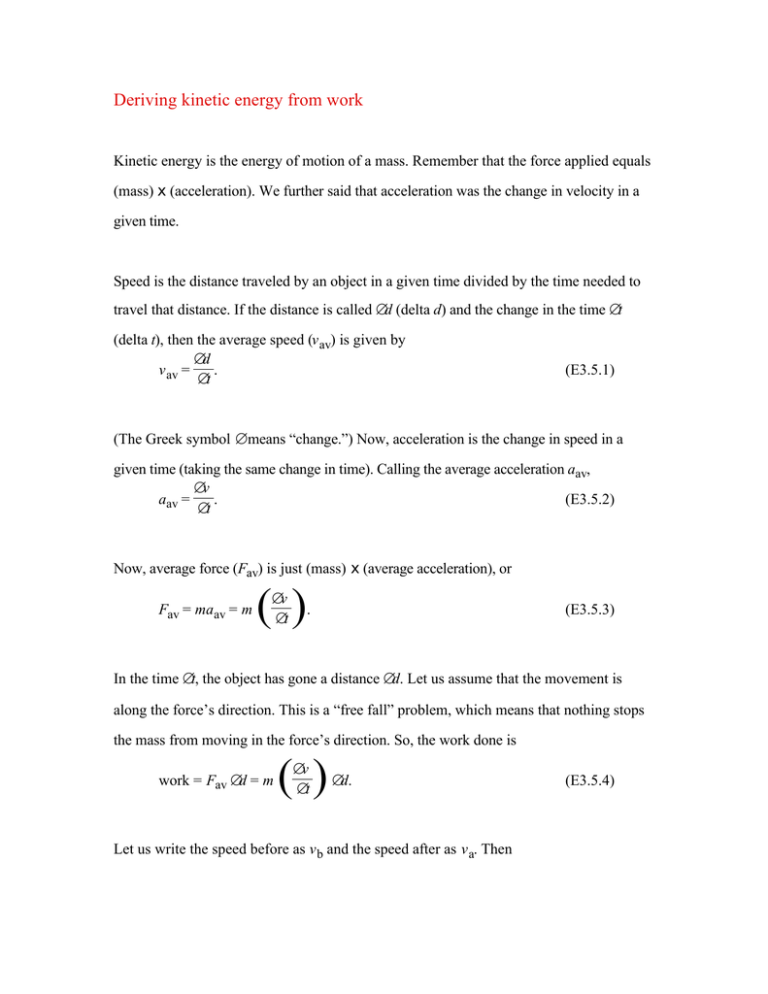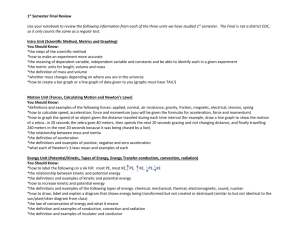Extension 3.5: Deriving Kinetic Energy from Work
advertisement

Deriving kinetic energy from work Kinetic energy is the energy of motion of a mass. Remember that the force applied equals (mass) x (acceleration). We further said that acceleration was the change in velocity in a given time. Speed is the distance traveled by an object in a given time divided by the time needed to travel that distance. If the distance is called ∆d (delta d) and the change in the time ∆t (delta t), then the average speed (v av) is given by ∆d v av = . ∆t (E3.5.1) (The Greek symbol ∆ means “change.”) Now, acceleration is the change in speed in a given time (taking the same change in time). Calling the average acceleration aav, ∆v aav = . (E3.5.2) ∆t Now, average force (Fav) is just (mass) x (average acceleration), or Fav = maav = m ∆v ∆t ( ) . (E3.5.3) In the time ∆t, the object has gone a distance ∆d. Let us assume that the movement is along the force’s direction. This is a “free fall” problem, which means that nothing stops the mass from moving in the force’s direction. So, the work done is work = Fav ∆d = m ∆v ∆t ( ) ∆d. Let us write the speed before as v b and the speed after as v a. Then (E3.5.4) Energy, Ch. 3, extension 5 Deriving kinetic energy from work work = Fav ∆d = m ( ) va - vb ∆t ∆d. 2 (E3.5.5) But ∆d is just the (average speed) x (change in time). In the same way that the average of 4 and 6 is (4 + 6)/2, or 5, the average speed during the 1 time interval ∆t is 2 (v a + v b) if the acceleration is constant. We may take the time interval to be small enough so we can assure that the acceleration is essentially constant during the interval. Therefore, we may write 1 ∆d = 2 (v a + v b) ∆t and rewrite Eq. E3.5.5.as 1 work = m (v b - v a) x 2 (v a + v b) 1 = 2 m (v a - v b)(v a + v b) 1 = 2 m (v a2 - v b2). (E3.5.5') Since this has to do with motion it is known as kinetic energy. If v b is zero, then we may write 1 kinetic energy = 2 mv a2. Generally, the kinetic energy corresponding to an object of mass m that has a speed v is found as 1 kinetic energy = 2 mv 2. (E3.5.6) Note that the unit of kinetic energy is the joule. Suppose you have a watermelon having mass of 10 kg, and you heave it at a speed of 5 m/s. Then the watermelon has a kinetic 1 energy of (2)(10 kg)(5 m/s)2 = 125 kg m2/s2 = 125 joules.


